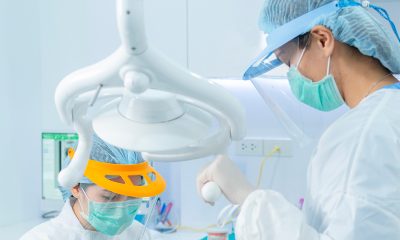Headband mounted task lighting
Surgical headlights are headband mounted task lights that produce a tightly controlled beam of light for optimal visualization of objects without reliance on cumbersome overhead lighting systems. Surgical procedures call for extraordinary precision and accuracy. Task lighting is crucial to creating an optimal visual environment. In operating rooms surgical lighting is primarily provided by overhead lights which are typically attached to an articulating suspension system mounted from the ceiling. However, overhead lighting systems may not always be able to adapt to surgeon’s needs. Medical procedures involving a small field of operation demand a constant, bright spot of light in the surgeon’s field of view, which cannot be catered by a typical overhead light due to the obstructions caused by the heads or shoulders of the surgical team.
Headlights are designed for surgeons looking for mobility and precision during surgical procedures. They direct a focused beam of light that chases away shadows from the surgeon’s vision to enable a clear view of the surgical site while keeping the hands free. Headlights are used in a variety of surgical specialties, including microsurgery, ophthalmology, neurosurgery, orthopedics, otorhinolaryngology, obstetrics, gynecology as well as vascular, cardiac, oral, maxillofacial, breast, plastic, cosmetic, minimally invasive/robotic, and general surgeries.
Legacy lighting technologies
Conventional surgical headlights are complex systems owing to the use of a light box and fiber optic cables. The light box, which is plugged into an AC power outlet, provides a source of light which is delivered to the headlight module through fiber optic cables. These lights are therefore commonly referred to as fiber optic lights. The light source of a fiber optic light is a xenon or halogen lamp.
Xenon head lights
Xenon lamps remain the first choice of light sources for demanding, critical applications due to its ability to produce high intensity, bright white light. Xenon lamps are gas discharge lamps that produce light by creating an electric arc between two electrodes in a glass bulb filled with pressurized xenon. Although they are substantially more expensive than typical halogen lamps, xenon lamps can produce twice the light of a halogen lamp while using only 2/3 the power. Also, they produce “whiter” daylight light with a high color temperature (around 6000 degrees Kelvin). These capabilities allow xenon headlights to provide significantly improved visibility over halogen counterparts. The power rating for commercially available xenon light sources used in light boxes varies between 100 and 300 watts.
Fiber optic head lights
Fiber optic headlights, however, are maintenance-heavy and deficient in mobility. The cumbersome light box prevents the user from being mobile. The use of heavy fiber optic cables can lead to neck-strain problems. Both halogen and xenon light sources contain a large amount of infrared (IR) energy in the light spectrum. The presence of radiant heat can cause patient discomfort or even intraoperative burns due to contact with heated fiber optic cables and/or light overexposure.
LED technology
As LED technology pushes the boundaries of energy efficiency and lighting performance, the popularity of LED surgical headlights is growing by leaps and bounds. The technology fundamentally changed the way that surgical headlights are designed and refined the usability and sustainability of headlights. LEDs are forward-biased p-n junction devices that emit light through the recombination of electron-hole pairs in the direct band gap semiconductors. The efficiency of LEDs has improved enormously over the past decade with the advent of phosphor-converted LEDs that use the indium gallium nitride-based (InGaN) material system.
- The luminous efficacy of white LEDs is way ahead of traditional technologies and continues to advance toward the practical limit of 255 lm/W for phosphor-converted LED architectures. This level of efficiency affords the headlights the chance of operating on battery power for practically longer periods. This eliminates the need for light boxes which involve the use of bulky belt packs or restrictive tethering cables, enabling total freedom of movement.
- LEDs produce cool infrared-free light which excludes the risk of drying out exposed tissue and intraoperative burns. The spectral power distribution (SPD) of LEDs can be precisely engineered to deliver the highest possible color rendering and most appropriate color.
- The small size and optical directionality of LEDs enable high efficiency optical control using small optical systems, which considerably reduces the weight and physical volume of the headlights.
- With solid state durability and semiconductor reliability, LEDs last much longer than xenon and halogen light sources.
System integration
An LED surgical headlight consists of a headlight module, a battery pack, and a headband. The headlight module includes LED module and optical system.
LED driver
The driver circuit that regulates power to the LED load is either integrated with the headlight module or incorporated in the battery pack. The LED module is assembly of a high power LED on a metal-core circuit board which is attached to the thermally conductive housing, forming a thermal path for transferring the waste heat from the LED junction to the ambient environment.
Optical system
The optical system controls the distribution of light emitted by the LED using lenses, reflectors, or a combination thereof. A uniform, hard beam must be created for surgical applications. The headlight module has a full range of articulation for optimal aiming of the beam. To provide optimum illumination of different-sized surgical sites, the beam size may be variable.
Light source
The high power LED is designed to exhibit visible spectrum radiation at all wavelengths of the spectrum for faithful color reproduction. The ability of the LED to properly render highly saturated colors, in particular the saturated solid red, is vital to differentiation of various shades of red with tissues and blood. The spectrum is also tuned to the desired correlated color temperature (CCT, typically in the range of 4000K to 5000K).
Battery
The battery can be incorporated onto the headband or designed as a belt pack. The rechargeable battery uses the lithium ion (Li-ion) chemistry which allows the battery to carry a very high energy density and a long cycle life. To accommodate the various visual needs of different procedures, LED headlights are often dimmable.










Loading...